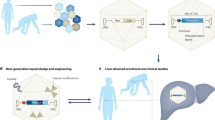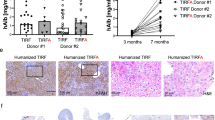Abstract
Adenoviral (AdV) and Adenovirus-associated viral (AAV) vectors both are used for in vivo gene therapy of inherited liver disorders, such as Crigler–Najjar syndrome type 1. In a relevant animal model, the Gunn rat, both vectors efficiently correct the severe hyperbilirubinemia characteristic of this liver disorder. Although the clinical use of AAV is more advanced, as demonstrated by the successful phase 1 trial in hemophilia B patients, because of its large cloning capacity AdV remains an attractive option. A direct comparison of the efficacy of these two vectors in the liver in a relevant disease model has not been reported. Aim of this study was to compare the efficiency of clinically applicable doses of both vectors in the Gunn rat. AdV or scAAV (self-complimentary AAV) ferrying identical liver-specific expression cassettes of the therapeutic gene, UGT1A1, were injected into the tail vein. As the titration methods of these two vectors are very different, a comparison based on vector titers is not valid. Therefore, their efficacy was compared by determining the amount of vector genomes delivered to the liver required for therapeutic correction of serum bilirubin. Like AAV, the liver-specific first-generation AdV also provided sustained correction in this relevant disease model. UGT1A1 mRNA expression provided per genome was comparable for both vectors. Flanking the expression cassette in AdV with AAV-ITRs (inverted terminal repeats), increased UGT1A1 mRNA expression eightfold which resulted in a significant improvement of efficacy. Compared with AAV, less AdV genomes were needed for complete correction of hyperbilirubinemia.
This is a preview of subscription content, access via your institution
Access options
Subscribe to this journal
Receive 12 print issues and online access
$259.00 per year
only $21.58 per issue
Buy this article
- Purchase on Springer Link
- Instant access to full article PDF
Prices may be subject to local taxes which are calculated during checkout






Similar content being viewed by others
References
Miranda PS, Bosma PJ . Towards liver-directed gene therapy for Crigler–Najjar syndrome. Curr Gene Ther 2009; 9: 72–82.
Bosma PJ . Inherited disorders of bilirubin metabolism. J Hepatol 2003; 38: 107–117.
Strauss KA, Robinson DL, Vreman HJ, Puffenberger EG, Hart G, Morton DH . Management of hyperbilirubinemia and prevention of kernicterus in 20 patients with Crigler–Najjar disease. Eur J Pediatr 2006; 165: 306–319.
Fox IJ, Chowdhury JR, Kaufman SS, Goertzen TC, Chowdhury NR, Warkentin PI et al. Treatment of the Crigler–Najjar syndrome type I with hepatocyte transplantation. N Engl J Med 1998; 338: 1422–1426.
Grieger JC, Samulski RJ . Adeno-associated virus as a gene therapy vector: vector development, production and clinical applications. Adv Biochem Eng Biotechnol 2005; 99: 119–145.
Wilson JM . Adenoviruses as gene-delivery vehicles. N Engl J Med 1996; 334: 1185–1187.
Connelly S . Adenoviral vectors for liver-directed gene therapy. Curr Opin Mol Ther 1999; 1: 565–572.
Snyder RO, Miao CH, Patijn GA, Spratt SK, Danos O, Nagy D et al. Persistent and therapeutic concentrations of human factor IX in mice after hepatic gene transfer of recombinant AAV vectors. Nat Genet 1997; 16: 270–276.
Koeberl DD, Alexander IE, Halbert CL, Russell DW, Miller AD . Persistent expression of human clotting factor IX from mouse liver after intravenous injection of adeno-associated virus vectors. Proc Natl Acad Sci USA 1997; 94: 1426–1431.
Askari FK, Hitomi Y, Mao M, Wilson JM . Complete correction of hyperbilirubinemia in the Gunn rat model of Crigler–Najjar syndrome type I following transient in vivo adenovirus-mediated expression of human bilirubin UDP-glucuronosyltransferase. Gene Therapy 1996; 3: 381–388.
Toietta G, Mane VP, Norona WS, Finegold MJ, Ng P, McDonagh AF et al. Lifelong elimination of hyperbilirubinemia in the Gunn rat with a single injection of helper-dependent adenoviral vector. Proc Natl Acad Sci USA 2005; 102: 3930–3935.
Dimmock D, Brunetti-Pierri N, Palmer DJ, Beaudet AL, Ng P . Correction of hyperbilirubinemia in Gunn rats using clinically relevant low doses of helper-dependent adenoviral vectors. Hum Gene Ther 2011; 22: 483–488.
McCaffrey AP, Fawcett P, Nakai H, McCaffrey RL, Ehrhardt A, Pham TT et al. The host response to adenovirus, helper-dependent adenovirus, and adeno-associated virus in mouse liver. Mol Ther 2008; 16: 931–941.
Nathwani AC, Tuddenham EG, Rangarajan S, Rosales C, McIntosh J, Linch DC et al. Adenovirus-associated virus vector-mediated gene transfer in hemophilia B. N Engl J Med 2011; 365: 2357–2365.
Seppen J, Bakker C, de JB, Kunne C, van den OK, Vandenberghe K et al. Adeno-associated virus vector serotypes mediate sustained correction of bilirubin UDP glucuronosyltransferase deficiency in rats. Mol Ther 2006; 13: 1085–1092.
Nathwani AC, Gray JT, Ng CY, Zhou J, Spence Y, Waddington SN et al. Self-complementary adeno-associated virus vectors containing a novel liver-specific human factor IX expression cassette enable highly efficient transduction of murine and nonhuman primate liver. Blood 2006; 107: 2653–2661.
Thummala NR, Ghosh SS, Lee SW, Reddy B, Davidson A, Horwitz MS et al. A non-immunogenic adenoviral vector, coexpressing CTLA4Ig and bilirubin-uridine-diphosphoglucuronateglucuronosyltransferase permits long-term, repeatable transgene expression in the Gunn rat model of Crigler–Najjar syndrome. Gene Therapy 2002; 9: 981–990.
Schaack J, Bennett ML, Shapiro GS, DeGregori J, McManaman JL, Moorhead JW . Strong foreign promoters contribute to innate inflammatory responses induced by adenovirus transducing vectors. Virology 2011; 412: 28–35.
Nakai M, Komiya K, Murata M, Kimura T, Kanaoka M, Kanegae Y et al. Expression of pIX gene induced by transgene promoter: possible cause of host immune response in first-generation adenoviral vectors. Hum Gene Ther 2007; 18: 925–936.
Gao GP, Alvira MR, Wang L, Calcedo R, Johnston J, Wilson JM . Novel adeno-associated viruses from rhesus monkeys as vectors for human gene therapy. Proc Natl Acad Sci USA 2002; 99: 11854–11859.
Li Q, Murphree SS, Willer SS, Bolli R, French BA . Gene therapy with bilirubin-UDP-glucuronosyltransferase in the Gunn rat model of Crigler–Najjar syndrome type 1. Hum Gene Ther 1998; 9: 497–505.
Yang Y, Nunes FA, Berencsi K, Furth EE, Gonczol E, Wilson JM . Cellular immunity to viral antigens limits E1-deleted adenoviruses for gene therapy. Proc Natl Acad Sci USA 1994; 91: 4407–4411.
Yang Y, Jooss KU, Su Q, Ertl HC, Wilson JM . Immune responses to viral antigens versus transgene product in the elimination of recombinant adenovirus-infected hepatocytes in vivo. Gene Therapy 1996; 3: 137–144.
Brooks AR, Harkins RN, Wang P, Qian HS, Liu P, Rubanyi GM . Transcriptional silencing is associated with extensive methylation of the CMV promoter following adenoviral gene delivery to muscle. J Gene Med 2004; 6: 395–404.
Breous E, Somanathan S, Bell P, Wilson JM . Inflammation promotes the loss of adeno-associated virus-mediated transgene expression in mouse liver. Gastroenterology 2011; 141: 357.
Pastore L, Morral N, Zhou H, Garcia R, Parks RJ, Kochanek S et al. Use of a liver-specific promoter reduces immune response to the transgene in adenoviral vectors. Hum Gene Ther 1999; 10: 1773–1781.
Haberman RP, McCown TJ, Samulski RJ . Novel transcriptional regulatory signals in the adeno-associated virus terminal repeat A/D junction element. J Virol 2000; 74: 8732–8739.
Wang CY, Wang S . Astrocytic expression of transgene in the rat brain mediated by baculovirus vectors containing an astrocyte-specific promoter. Gene Therapy 2006; 13: 1447–1456.
Johnston KM, Jacoby D, Pechan PA, Fraefel C, Borghesani P, Schuback D et al. HSV/AAV hybrid amplicon vectors extend transgene expression in human glioma cells. Hum Gene Ther 1997; 8: 359–370.
Flotte TR, Afione SA, Solow R, Drumm ML, Markakis D, Guggino WB et al. Expression of the cystic fibrosis transmembrane conductance regulator from a novel adeno-associated virus promoter. J Biol Chem 1993; 268: 3781–3790.
Fagone P, Wright JF, Nathwani AC, Nienhuis AW, Davidoff AM, Gray JT . Systemic errors in quantitative polymerase chain reaction titration of self-complementary adeno-associated viral vectors and improved alternative methods. Hum Gene Ther Methods 2012; 23: 1–7.
Seppen J, Bosma PJ, Goldhoorn BG, Bakker CT, Chowdhury JR, Chowdhury NR et al. Discrimination between Crigler–Najjar type I and II by expression of mutant bilirubin uridine diphosphate-glucuronosyltransferase. J Clin Invest 1994; 94: 2385–2391.
Montenegro-Miranda PS, Sneitz N, de Waart DR, Ten BL, Duijst S, de Knegt RJ et al. Ezetimibe: a biomarker for efficacy of liver directed UGT1A1 gene therapy for inherited hyperbilirubinemia. Biochim Biophys Acta 2012; 1822: 1223–1229.
He TC, Zhou S, da Costa LT, Yu J, Kinzler KW, Vogelstein B . A simplified system for generating recombinant adenoviruses. Proc Natl Acad Sci USA 1998; 95: 2509–2514.
Bewig B, Schmidt WE . Accelerated titering of adenoviruses. Biotechniques 2000; 28: 870–873.
Boom R, Sol CJ, Heijtink R, Wertheim-van Dillen PM, van der Noordaa J . Rapid purification of hepatitis B virus DNA from serum. J Clin Microbiol 1991; 29: 1804–1811.
Ruijter JM, Ramakers C, Hoogaars WM, Karlen Y, Bakker O, van den Hoff MJ et al. Amplification efficiency: linking baseline and bias in the analysis of quantitative PCR data. Nucleic Acids Res 2009; 37: e45.
Acknowledgements
We thank the gene therapy lab of Nantes for production of the Adenoviral vectors. This work has been supported by a grant from ZonMw to PJB and from AFM to NF.
Author information
Authors and Affiliations
Corresponding author
Ethics declarations
Competing interests
The authors declare no conflict of interest.
Additional information
Supplementary Information accompanies this paper on Gene Therapy website
Supplementary information
Rights and permissions
About this article
Cite this article
Montenegro-Miranda, P., Pichard, V., Aubert, D. et al. In the rat liver, Adenoviral gene transfer efficiency is comparable to AAV. Gene Ther 21, 168–174 (2014). https://doi.org/10.1038/gt.2013.69
Received:
Revised:
Accepted:
Published:
Issue Date:
DOI: https://doi.org/10.1038/gt.2013.69
Keywords
This article is cited by
-
Novel Role of HAX-1 in Neurons Protection After Spinal Cord Injury Involvement of IRE-1
Neurochemical Research (2020)
-
Gene Replacement Therapy for Genetic Hepatocellular Jaundice
Clinical Reviews in Allergy & Immunology (2015)



